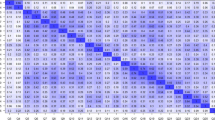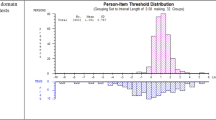Abstract
Purpose
The purpose of this study was to analyze the factor structure of the abbreviated Spanish version of the World Health Organization Quality of Life (WHOQOL-BREF; WHOQOL Group in Psychol Med 28(3): 551–558, 1998b) questionnaire in a sample of individuals from several Spanish-speaking countries.
Method
The data were based on a sample of 1,972 undergraduates from nine Spanish-speaking countries. Within the framework of a somewhat wider research protocol, they were administered the WHOQOL-BREF.
Results
The data were initially analyzed using a confirmatory factor analysis, which yielded a poor fit to the four-factor theoretical model. Based on these results, the best solution was estimated assuming structural invariance across countries. The data showed a four-factor structure that differed slightly from the model proposed. This four-factor model was subsequently analyzed using exploratory structural equation modeling (ESEM; Asparouhov and Muthén in Struct Equ Model 16(3): 397–438, 2009) to obtain the invariant structure across countries and an estimation of the relation between the four latent factors. The results obtained allowed us to establish that the factor structure of WHOQOL-BREF maintains the four-factor solution hypothesized for a Spanish-speaking population, although the solution has a different and more complex configuration than the original one with a clear tendency toward non-orthogonality of the latent factors.
Conclusions
As has been suggested by some studies on the application of ESEM, it is reasonable to think that the ESEM approximation is a useful approach for conducting the factor analysis of instruments measuring complex psychological phenomena.
Similar content being viewed by others
References
WHOQOL Group. (1995). The World Health Organization Quality of life assessment (WHOQOL): Position paper from the world health organization. Social Science and Medicine, 41(10), 1403–1409.
WHOQOL Group. (1998). The World Health Organization Quality of Life assessment (WHOQOL): Development and general psychometric properties. Social Science and Medicine, 46(12), 1569–1585.
Li, L., Young, D., Xiao, S., Zhou, X., & Zhou, L. (2004). Psychometric properties of the WHO Quality of life Questionnaire (WHOQOL-100) in patients with chronic diseases and their caregivers in China. Bulletin of the World Health Organization, 82(7), 493–502.
WHOQOL Group. (1998). Development of the World Health Organization WHOQOL-BREF quality of life assessment. Psychological Medicine, 28(3), 551–558.
Skevington, S. M., Lotfy, M., & O’Connell, K. A. (2004). The World Health Organization’s WHOQOL-BREF quality of life assessment: Psychometric properties and results of the international field trial. A Report from the WHOQOL Group. Quality of Life Research, 13(2), 299–310.
Saxena, S., Carlson, D., Billington, R., & Orley, J. (2001). The WHO quality of life assessment instrument (WHOQOL-BREF): The importance of its items for cross-cultural research. Quality of Life Research, 10(8), 711–721.
Fleck, M. P., Louzada, S., Xavier, M., Chachamovich, E., Vieira, G., Santos, L., et al. (2000). Application of the Portuguese version of the abbreviated instrument of quality of life WHOQOL-BREF. Revista de Saúde Pública, 34(2), 178–283.
Min, S., Kim, K., Lee, C., Jung, Y., Suh, S., & Kim, D. (2002). Development of the Korean versions of WHO Quality of Life scale and WHOQOL-BREF. Quality of Life Research, 11(6), 593–600.
Noerholm, V., Groenvold, M., Watt, T., Bjorner, J., Rasmussen, N., & Bech, P. (2004). Quality of life in the Danish general population—normative data and validity of WHOQOL-BREF using Rasch and item response theory models. Quality of Life Research, 13(2), 531–540.
Von Steinbüchel, N., Lischetzke, T., Gurny, M., & Eid, M. (2006). Assessing quality of life in older people: Psychometric properties of the WHOQOL-BREF. European Journal of Ageing, 3(2), 116–122.
Yao, G., Chung, C., Yu, C., & Wang, J. (2002). Development and verification of validity and reliability of the WHOQOL-BREF Taiwan version. Journal of Formosan Medical Association, 101(5), 342–351.
Barros da Silva, A., Fleck, M., Pechansky, F., de Boni, R., & Sukop, P. (2005). Psychometric properties of the World Health Organization Quality of Life instrument (WHOQOL-BREF) in alcoholic males: A pilot study. Quality of Life Research, 14(2), 473–478.
Berlim, M., Pavanello, D., Caldieraro, M., & Fleck, M. (2005). Reliability and validity of the WHOQOL BREF in a sample of Brazilian outpatients with major depression. Quality of Life Research, 14(2), 561–564.
Fang, C., Hsiung, P., Yu, C., Chen, M., & Wan, J. (2002). Validation of the World Health Organization Quality of Life instrument in patients with HIV infection. Quality of Life Research, 11(8), 753–762.
Izutsu, T., Tsutsumi, A., Islam, A., Matsuo, Y., Sayuri, H., Kurita, H., et al. (2005). Validity and reliability of the Bangla version of WHOQOL-BREF on an adolescent population in Bangladesh. Quality of Life Research, 14(7), 1783–1789.
Jang, Y., Hsieh, C., Wang, Y., & Wu, Y. (2004). A Validity study of the WHOQoL-BREF assessment in persons with traumatic spinal cord injury. Archives of Physical Medicine Rehabilitation, 85(11), 1890–1895.
Lucas-Carrasco, R., Laidlaw, K., & Power, M. J. (2011). Suitability of the WHOQOL-BREF and WHOQOL-OLD for Spanish older adults. Aging and Mental Health, 15(5), 595–604.
Moreno, A., Faerstein, E., Werneck, G., Lopes, C., & Chor, D. (2006). Psychometric properties of the World Health Organization abbreviated instrument for quality of life assessment in the Pró-Saúde Study. Cadernos de Saúde Pública, 22(12), 2585–2597.
Trompenaars, F., Masthoff, E., Van Heck, G., Hodiamont, P., & De Vries, J. (2005). Content validity, construct validity, and reliability of the WHOQoL-Bref in a population of Dutch adult psychiatric outpatients. Quality of Life Research, 14(1), 151–160.
Yao, G., Wu, C., & Yang, C. (2008). Examining the content validity of the WHOQOL-BREF from respondents’ perspective by quantitative methods. Social Indicators Research, 85(3), 483–498.
Espinoza, I., Osorio, P., & Torrejón, M. J. (2011). Validación del cuestionario de calidad de vida (WHOQOL-BREF) en adultos mayores chilenos. Revista Médica de Chile, 139, 579–586.
Lucas-Carrasco, R. (1998). Versión Española del WHOQOL. Ergón, D.L.: División de Salud Mental. Organización Mundial de la Salud. Madrid. ISBN 84-89834-32-6.
Asparouhov, T., & Muthén, B. (2009). Exploratory structural equation modeling. Structural Equation Modeling, 16(3), 397–438.
World Health Organization. (1996). WHOQOL-BREF: Introduction, administration, scoring and generic version of the assessment. Field trial version. Geneva: Programme on mental health.
Marsh, H. W., Muthén, B., Asparouhov, T., Lüdtke, O., Robitzsch, A., Morin, A., et al. (2009). Exploratory structural equation modeling, interpretating CFA and EFA: Application to student’s evaluations of university teaching. Structural Equation Modeling, 16(3), 439–476.
Marsh, H. W., Muthén, B., Morin, A., Lüdtke, O., Asparouhov, T., Trautwein, U., et al. (2010). A new look at the big five factor structure through exploratory structural equation modeling. Psychological Assessment, 22(3), 471–491.
Hu, L. T., & Bentler, P. M. (1999). Cutoff criteria for fit indexes in covariance structure analysis: Conventional criteria versus new alternatives. Structural Equation Modeling, 6(1), 1–55.
Bentler, P. M. (1990). Comparative fit indexes in structural models. Psychological Bulletin, 107(2), 238–246.
Browne, M. W., & Cudeck, R. (1993). Alternative ways of assessing model fit. In K. A. Bollen & J. S. Long (Eds.), Testing structural equation models (pp. 136–162). Beverly Hills, CA: Sage.
Chahin, N., Cosi, S., Lorenzo-Seva, U., & Vigil-Colet, A. (2010). Stability of the factor structure of Barrat’s Impulsivity Scales for children across cultures: A comparison of Spain and Colombia. Psicothema, 22(4), 983–989.
Lucas-Carrasco, R. (2012). The WHO quality of life (WHOQOL) questionnaire: Spanish development and validation studies. Quality of Life Research, 21, 161–165.
Acknowledgments
This study was supported by the Agència de Gestió d’Ajuts Universitaris i de Recerca de la Generalitat de Catalunya and the Grup de Recerca en Tècniques Estadístiques Avançades Aplicades a la Psicologia (GTEAAP). This research was made possible by the PSI2010-21214-C02-01 project and was carried out by members of the Generalitat de Catalunya’s SGR 388 Consolidated Research Group.
Author information
Authors and Affiliations
Corresponding author
Rights and permissions
About this article
Cite this article
Benitez-Borrego, S., Guàrdia-Olmos, J. & Urzúa-Morales, A. Factorial structural analysis of the Spanish version of WHOQOL-BREF: an exploratory structural equation model study. Qual Life Res 23, 2205–2212 (2014). https://doi.org/10.1007/s11136-014-0663-2
Accepted:
Published:
Issue Date:
DOI: https://doi.org/10.1007/s11136-014-0663-2




